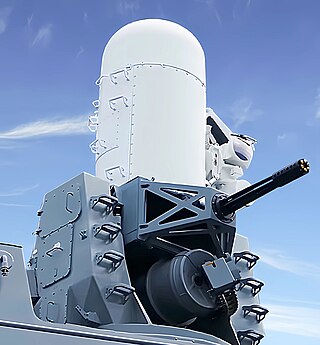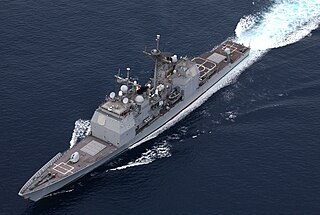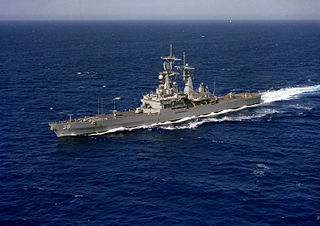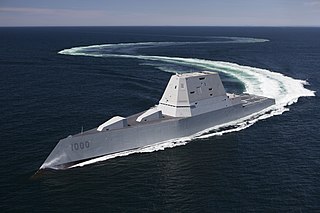
The Phalanx CIWS is an automated gun-based close-in weapon system to defend military watercraft automatically against incoming threats such as aircraft, missiles, and small boats. It was designed and manufactured by the General Dynamics Corporation, Pomona Division, later a part of Raytheon. Consisting of a radar-guided 20 mm (0.8 in) Vulcan cannon mounted on a swiveling base, the Phalanx has been used by the United States Navy and the naval forces of 15 other countries. The US Navy deploys it on every class of surface combat ship, except the Zumwalt-class destroyer and San Antonio-class amphibious transport dock. Other users include the British Royal Navy, the Royal Australian Navy, the Royal New Zealand Navy, the Royal Canadian Navy, and the U.S. Coast Guard.

The Arleigh Burke class of guided-missile destroyers (DDGs) is a United States Navy class of destroyer centered around the Aegis Combat System and the SPY-1D multi-function passive electronically scanned array radar. The class is named for Admiral Arleigh Burke, an American destroyer officer in World War II and later Chief of Naval Operations. With an overall length of 505 to 509.5 feet, displacement ranging from 8,300 to 9,700 tons, and weaponry including over 90 missiles, the Arleigh Burke-class destroyers are larger and more heavily armed than many previous classes of guided-missile cruisers.

The Aegis Combat System is an American integrated naval weapons system, which uses computers and radars to track and guide weapons to destroy enemy targets. It was developed by the Missile and Surface Radar Division of RCA, and it is now produced by Lockheed Martin.

USS Arleigh Burke (DDG-51), named for Admiral Arleigh A. Burke, USN (1901–1996), is the lead ship of the Arleigh Burke-class guided-missile destroyers. She was laid down by the Bath Iron Works company at Bath, Maine, on 6 December 1988; launched on 16 September 1989; and commissioned on 4 July 1991.

The Spruance-class destroyer was developed by the United States to replace the many World War II–built Allen M. Sumner- and Gearing-class destroyers, and was the primary destroyer built for the United States Navy during the 1970s and 1980s. It was named in honor of U.S. Navy Admiral Raymond A. Spruance, who successfully led major naval battles in the Asiatic-Pacific Theater during World War II such as the Battle of Midway and the Battle of the Philippine Sea.

The Charles F. Adams class is a ship class of 29 guided-missile destroyers (DDG) built between 1958 and 1967. Twenty-three were built for the United States Navy, three for the Royal Australian Navy, and three for the West German Bundesmarine. The design of these ships was based on that of Forrest Sherman-class destroyers, but the Charles F. Adams class were the first class designed to serve as guided-missile destroyers. 19 feet (5.8 m) of length was added to the center of the design of the Forrest Sherman class to carry the ASROC launcher. The Charles F. Adams-class were the last steam turbine-powered destroyers built for the U.S. Navy. Starting with the succeeding Spruance-class, all U.S. Navy destroyers have been powered by gas turbines. Some of the U.S. Charles F. Adams class served during the blockade of Cuba in 1962 and during the Vietnam War; those of the Royal Australian Navy served during the Vietnam War and Gulf War.

USS John Paul Jones (DDG-53) is the third Arleigh Burke-class guided missile destroyer in the United States Navy and the first ship of the class homeported on the west coast. She is the fifth ship named after American Revolutionary War naval captain John Paul Jones and the second to carry his first name. She was built at Bath Iron Works in Bath, Maine. The ship is part of Destroyer Squadron 9 of Carrier Strike Group 11, which is headed by the nuclear-powered aircraft carrier USS Nimitz (CVN-68).

The Ticonderoga class of guided-missile cruisers is a class of warships of the United States Navy, first ordered and authorized in the 1978 fiscal year. It was originally planned as a class of destroyers. However, the increased combat capability offered by the Aegis Combat System and the passive phased array AN/SPY-1 radar, together with the capability of operating as a flagship, were used to justify the change of the classification from DDG to CG shortly before the keels were laid down for Ticonderoga and Yorktown.

The Virginia class were four nuclear-powered, guided-missile cruisers that served in the United States Navy until the mid-to-late 1990s. The double-ended cruisers were commissioned between 1976 and 1980. They were the final class of nuclear-powered cruisers completed and the last ships ordered as Destroyer Leaders under the pre-1975 classification system.

The Zumwalt-class destroyer is a class of three United States Navy guided-missile destroyers designed as multi-mission stealth ships with a focus on land attack. The class was designed with a primary role of naval gunfire support and secondary roles of surface warfare and anti-aircraft warfare. The class design emerged from the DD-21 "land attack destroyer" program as "DD(X)" and was intended to take the role of battleships in meeting a congressional mandate for naval fire support. The ship is designed around its two Advanced Gun Systems (AGS), turrets with 920 round magazines, and unique Long Range Land Attack Projectile (LRLAP) ammunition. LRLAP procurement was canceled, rendering the guns unusable, so the Navy re-purposed the ships for surface warfare. Starting in 2023, the Navy will remove the AGS from the ships and replace them with hypersonic missiles.

The AN/SLQ-32 is a shipboard electronic warfare suite built by the Raytheon Company of Goleta, California and The Hughes Aircraft Company. It is currently the primary electronic warfare system in use by U.S. Navy ships. Its operators commonly refer to it as the "Slick-32".

The CG(X) program, also known as the Next Generation Cruiser program, was a United States Navy research program to develop a replacement vessel for its 22 Ticonderoga-class cruisers. Original plans were for 18–19 ships, based on the 14,500 ton Zumwalt-class destroyer with additional ballistic missile defense and area air defense for a carrier group. These vessels were to enter service beginning in 2017. The program was ended in 2010 with its mission to be fulfilled by the successor to the Flight III Arleigh Burke-class destroyers.

The 5" /54 caliber lightweight gun is a U.S. naval artillery gun mount consisting of a 5 in (127 mm) L54 Mark 19 gun on the Mark 45 mount. It was designed and built by United Defense, a company later acquired by BAE Systems Land & Armaments, which continued manufacture.

New Threat Upgrade (NTU) was a United States Navy program to improve and modernize the capability of existing cruisers and destroyers equipped with Terrier and Tartar anti-aircraft systems, keeping them in service longer.

The RIM-66 Standard MR (SM-1MR/SM-2MR) is a medium-range surface-to-air missile (SAM), with a secondary role as an anti-ship missile, developed for the United States Navy (USN). A member of the Standard Missile family of weapons, the SM-1 was developed as a replacement for the RIM-2 Terrier and RIM-24 Tartar that were deployed in the 1950s on a variety of USN ships. The RIM-67 Standard (SM-1ER/SM-2ER) is an extended range version of this missile with a solid rocket booster stage.

The AN/SPY-6 is an active electronically scanned array 3D radar under development for the United States Navy (USN). It will provide integrated air and missile defense for Flight III Arleigh Burke-class destroyers. Variants are under development for retrofitting Flight IIA Arleigh Burkes and for installation aboard Constellation-class frigates, Gerald R. Ford-class aircraft carriers, America-class amphibious assault ships, and San Antonio-class amphibious transport docks.

The AN/SPY-1 is a United States Navy 3D radar system manufactured by Lockheed Martin. The array is a passive electronically scanned system and a key component of the Aegis Combat System. The system is computer controlled and uses four complementary antennas to provide 360-degree coverage. The system was first installed in 1973 on USS Norton Sound and entered active service in 1983 as the SPY-1A on USS Ticonderoga. The -1A was installed on ships up to CG-58, with the -1B upgrade first installed on USS Princeton in 1986. The upgraded -1B(V) was retrofitted to existing ships from CG-59 up to the last, USS Port Royal.

The Mark 41 Vertical Launching System is a shipborne missile canister launching system which provides a rapid-fire launch capability against hostile threats. The Vertical Launch System (VLS) concept was derived from work on the Aegis Combat System.

The Mark 34 Gun Weapon System (GWS) is a component of the Aegis Combat System that is responsible for controlling and providing fire control to the 5" Mark 45 gun. It is used on the U.S. Navy Arleigh Burke-class destroyer and several later Ticonderoga-class cruisers. The Mk 34 GWS receives target data from the ship's sensors and off-ship sources, performs ballistic calculations, and produces gun control orders. The system is made up of the gun mount itself, the fire-control computer, and an optical sight.

The DDG(X) or Next-Generation Guided-Missile Destroyer program of the United States Navy aims to develop a class of surface combatants to succeed 22 Flight II Ticonderoga-class cruisers and 28 Flight I/II Arleigh Burke-class destroyers. The program is the culmination of the Large Surface Combatant (LSC) initiative that followed the cancellation of CG(X) and curtailing of the procurement of the Zumwalt-class destroyers. The ships will become the principal large surface combatants of the U.S. Navy; compared to their predecessors, they will incorporate more powerful sensors and have more room and weight margin for growth.





















